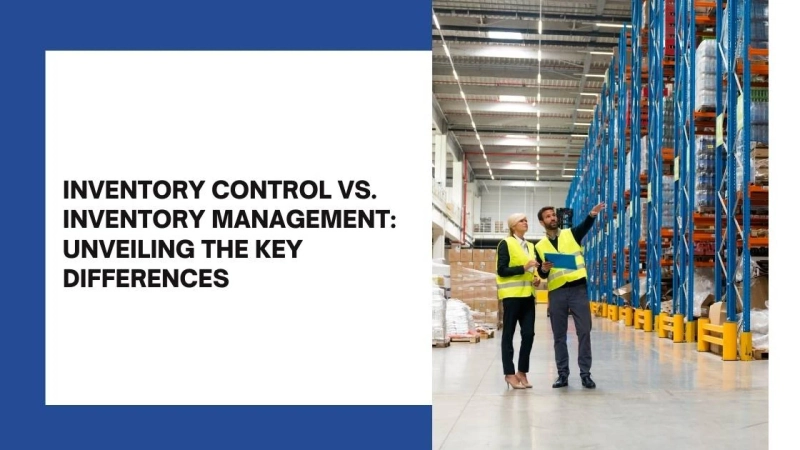In the dynamic landscape of business operations, the terms "Inventory Control" and "Inventory Management" are often used interchangeably, leading to confusion. However, these two concepts play distinct roles in the success of an organisation. In this comprehensive article, we will delve into the world of Inventory Control and Inventory Management, highlighting their differences and their crucial roles in ensuring businesses' efficiency and profitability.
Defining Inventory Control
Inventory control is like the carefully choreographed dance of managing everything a company keeps in its storage. It's the practical part of handling these items, where we pay close attention to how much we have and when we need to reorder. The main goal? To keep costs down while ensuring we always have enough goodies to satisfy our customers. Think of it as the behind-the-scenes magic that keeps the store shelves stocked and customers happy.
Critical Elements of Inventory Control
Stock Levels: Controlling the optimum inventory level to prevent overstocking or stockouts is paramount. This includes monitoring reorder points and safety stock.
Stock Tracking: Efficient tracking methods, often employing technology like barcoding or RFID, are crucial for keeping tabs on inventory in real time.
Order Management: Streamlining the ordering process to ensure orders are placed promptly, avoiding bottlenecks in the supply chain.
Quality Control: Maintaining the quality of products in stock to prevent wastage and returns.
Understanding Inventory Management
Inventory Management, on the other hand, is a broader concept that encompasses the entire lifecycle of inventory. It's the strategic side of handling inventory, focusing on the planning and control of inventory from procurement to its end use. Inventory Management aims to balance having enough inventory to meet customer demands while minimising holding costs.
Critical Elements of Inventory Management
Demand Forecasting: Accurately predicting customer demand is essential in Inventory Management. It involves analysing historical data and market trends.
Supplier Relations: Building and maintaining solid relationships with suppliers to ensure a steady and cost-effective supply of inventory.
Strategic Planning: Creating inventory policies, setting service levels, and defining inventory turnover rates.
Technology Integration: Implementing advanced software and systems to streamline inventory management.
Now, let's dive into the key differences between Inventory Control and Inventory Management.
Differentiating Inventory Control and Inventory Management
Scope:
Inventory Control: Focuses on the day-to-day management of inventory items, emphasising stock levels, tracking, and ordering.
Inventory Management: Encompasses the entire inventory process, from procurement and storage to distribution and demand forecasting.
Objectives:
Inventory Control: This aims to minimise holding costs, prevent stockouts, and ensure product quality.
Inventory Management: Aims to optimise inventory levels to meet customer demand efficiently while minimising carrying costs.
Time Horizon:
Inventory Control: Operates short-term, dealing with immediate stock-related issues.
Inventory Management: Takes a long-term perspective involving strategic planning and forecasting.
Strategic vs. Tactical:
Inventory Control: Tactical and operational.
Inventory Management: Strategic and encompasses both tactical and functional aspects.
Why Both Are Essential?
The synergy between Inventory Control and Inventory Management is vital for business success. Inventory Control ensures that day-to-day operations run smoothly, preventing stockouts and reducing holding costs. Simultaneously, Inventory Management provides the strategic vision required to optimise inventory levels, forecast demand, and maintain healthy supplier relationships.
By integrating Inventory Control and Inventory Management effectively, businesses can achieve the delicate balance of ensuring product availability while keeping costs in check. This equilibrium leads to higher customer satisfaction, increased profitability, and a competitive edge in the market.
Benefits for Businesses
1. Cost Reduction
By working together, Inventory Control and Inventory Management help minimise holding costs and prevent overstocking or stockouts. This cost-efficiency is critical for businesses, directly impacting the bottom line.
2. Optimised Inventory Levels
The integration ensures that inventory levels are maintained at an optimal level, preventing understocking that can result in missed sales opportunities or unnecessary overstocking that ties up capital.
3. Enhanced Customer Satisfaction
With accurate demand forecasting and efficient order management, businesses can consistently meet customer demands. This leads to increased customer satisfaction and loyalty.
4. Improved Supplier Relations
Inventory Management often involves building and maintaining solid supplier relationships. This ensures a steady and cost-effective supply of inventory, which is essential for smooth operations.
5. Operational Efficiency
Combining both approaches streamlines the entire inventory process, reducing manual errors, delays, and inefficiencies. This can lead to smoother operations and fewer disruptions.
6. Strategic Advantage
Integration allows businesses to take a strategic approach to inventory, aligning it with overall business goals. This strategic advantage can set them apart from competitors.
7. Competitive Edge
Ultimately, integrating Inventory Control and Inventory Management contributes to a competitive edge in the market. Businesses that consistently meet customer demand while keeping costs in check are better positioned to succeed.
Final Thoughts
Inventory Control and Inventory Management are not two sides of the same coin but complementary aspects of inventory handling. The key to success is recognising their differences and implementing strategies harmonising these two critical functions. By doing so, businesses can set themselves on the path to operational excellence and enhanced profitability.
Accurate Warehousing and Distribution stands as a prominent leader in the realm of Las Vegas warehouse, offering world-class inventory control services. Our commitment to excellence is demonstrated through substantial investments in cutting-edge technology, all aimed at enhancing our operational efficiency. Our inventory control program is a versatile solution, adept at accommodating both short-term and long-term warehousing needs, as well as efficient cross-docking services.
Name: Accurate Warehousing and Distribution
Address: 6585 Escondido Street Ste B. Las Vegas
Phone No: (702) 777-0300


